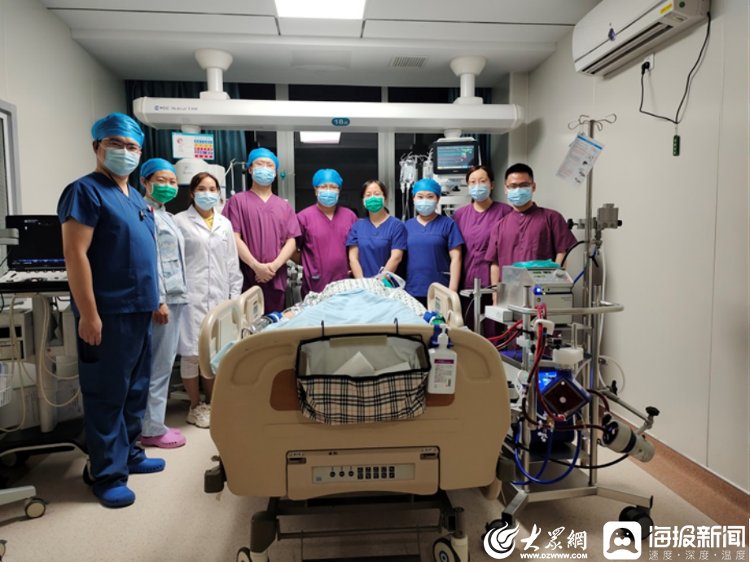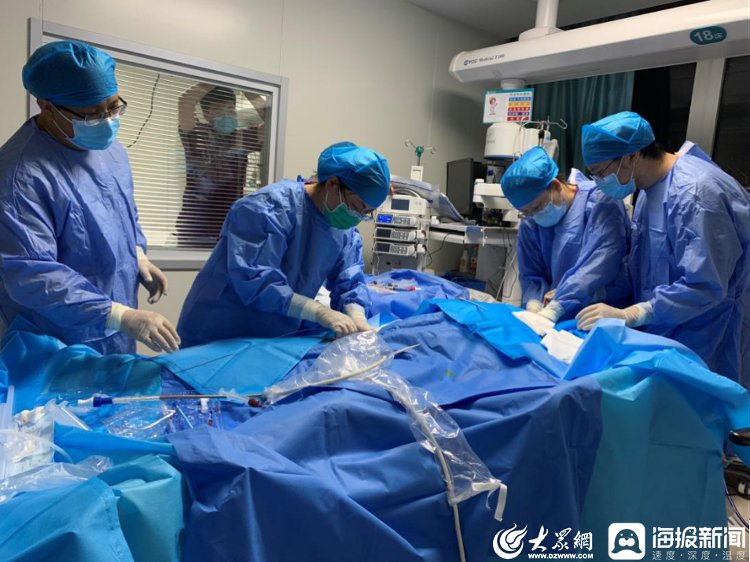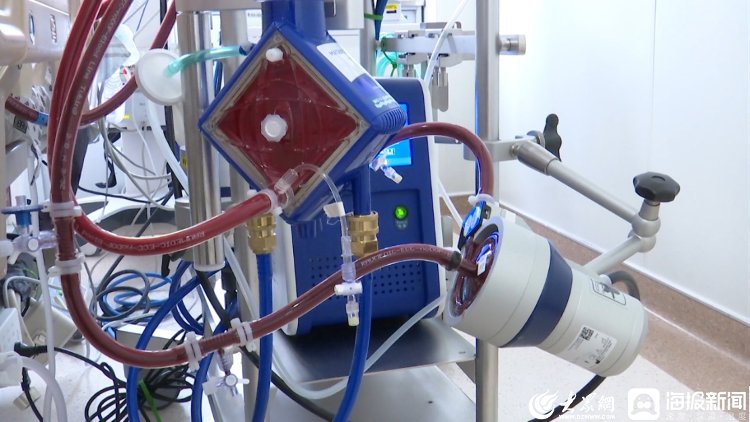Dazhong Net·Poster News reporter Dong Haoqian reported from Jinan
Recently, the Third Provincial Hospital of Shandong Province used ECMO (Extracorporeal Membrane Oxygenation) to treat a 31-year-old Zhao Gang (pseudonym), a patient with severe respiratory failure.
In the early morning of June 7th, the hospital’s intensive care team from the pre-flushing, connection, vascular puncture and catheterization, to the successful ECMO on the machine, took less than 1 hour to set up the “patient”. the way of life”.
A door inside and outside, between life and death. This place is very close to death and not far from rebirth. It is the team from the Department of Critical Care Medicine of the Third Shandong Provincial Hospital who gives hope to patients and never gives up easily.
 In the early morning of the 7th, a group photo of medical staff participating in ECMO treatment.
In the early morning of the 7th, a group photo of medical staff participating in ECMO treatment.
Airway spasm, the 31-year-old boy’s life is at stake
He suffered from asthma before the age of 1, and Zhao Gang suffered from asthma during his 31-year career , seldom experience the taste of comfortable breathing.
“He fell ill when he was a child, we simply gave him some medicine, and then he took the medicine himself.” Zhao Gang’s family said that due to the limited economic conditions of the family, Zhao Gang’s asthma has never been diagnosed in the past 30 years. standardized treatment.
At the beginning of June this year, my asthma attacked again. Zhao Gang was still the same as usual, thinking that he could survive with a little medicine, but he didn’t expect that this attack almost cost him his life.
On the afternoon of June 5, Zhao Gang felt very difficult to breathe. His family realized that something was wrong and immediately sent him to the emergency room of the Shandong Provincial Third Hospital. However, after a day of treatment, his symptoms did not ease, and he was admitted to the ICU (Intensive Medicine Department) on the 6th.
“When he first arrived in the ICU, he was so breathless that he couldn’t lie down at all, so he could only sit upright.” Yao Yanfen, director of the Department of Critical Care Medicine of the Third Shandong Provincial Hospital, introduced that in order to relieve Zhao Gang’s symptoms as soon as possible Painful, they immediately gave Zhao Gang non-invasive mechanical ventilation and drugs to treat asthma. As the disease progressed, Zhao Gang became confused, and the medical staff urgently inserted an endotracheal intubation for him, but the situation was still not optimistic.
“He suffered from airway spasm due to asthma, and the ventilator couldn’t deliver air at all.” At that time, Zhao Gang’s heart rate and blood pressure were unstable. The alarm sound of the life monitoring equipment sounded frequently, and this situation continued, and the mortality rate of the patient was close to 100%!
With her life hanging on the line, Yao Yanfan and her team members, after careful analysis, believe that only by allowing the patient’s lungs to rest through ECMO can they win the first-line hope.
“Get on ECMO!” Yao Yanfan immediately arranged for the doctor on duty to talk to Zhao Gang’s family. After discussion, the family agreed to use ECMO for Zhao Gang to fight for the last chance.
 Use ECMO to treat the scene.
Use ECMO to treat the scene.
The team went into battle and fought a life-saving battle
For better treatment, the critical care medicine of Shandong Third Provincial Hospital All members of the ECMO team came into play. At 23:00 on the 6th, Yao Yanfen, director of the department, urgently called back 5 doctors, and all the medical staff cooperated closely under the guidance of experts.
“From the moment the nurse pre-flushed the tube, the doctor started to prepare the tube for disinfection, laying out sheets, and at the same time preparing the tube for puncture.” She introduced that the doctor should place catheters in Zhao Gang’s internal jugular and femoral veins at the same time. Two tubes are punctured, and each tube needs to be operated by two doctors at the same time. “You can’t wait for the doctor above to puncture the bottom before puncturing the bottom, because the tube is very thick and it is easy to form thrombus inside, so it must be synchronized.”
After the placement of the tube, the fifth doctor immediately used ultrasound to preliminarily confirm the position of the tube. Meanwhile, the nurse gets the ECMO machine running.
“No problem with tube placement!” With this confirmation, the machine started to operate normally.
This is a successful life-defense battle. At this time, it was 1 am on the 7th.
“After the machine is running normally, we have to make sure that its revolutions and flow are all right.” Yao Yanfan said that Zhao Gang’s breathing improved significantly after only a few minutes of using ECMO. After a period of observation by the medical staff, it was confirmed that his symptoms gradually improved before giving a fixed circuit.
Before ECMO, the partial pressure of carbon dioxide in Zhao Gang’s arterial blood continued to exceed 115mmHg, while the normal value of carbon dioxide partial pressure in ordinary human blood was only 35-45mmHg. After less than 24 hours of ECMO treatment, Zhao Gang’s partial pressure of carbon dioxide stabilized at a normal level, and he is recovering steadily. The carbon dioxide retention and severe hypoxemia have been significantly improved, and the heart rate has increased from the fastest 150 beats/min. It dropped to 90 beats/min, and the blood pressure was basically stable.

 ECMO works normally.
ECMO works normally.
2 doctors and 2 nurses should guard the bed at the same time
It is worth noting that the follow-up management of ECMO treatment is also A major hurdle, such as bleeding/thrombosis problems during anticoagulation, hemolysis problems that may occur during transfer, and infection problems caused by catheter placement, etc. In order to successfully pass this level, the Department of Critical Care Medicine has always ensured that there are 2 nurses and 2 doctors guarding Zhao Gang’s bed at the same time, adjusting the parameters of the machine at any time according to the monitoring indicators.
In Yao Yanfan’s view, all the hard work is worth it. Because everyone is an indispensable part of the family, as long as the patient has 1% hope, they must put in 100% effort.